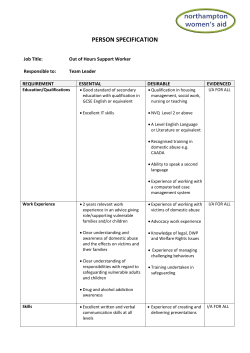
Source of referrals - Canadian Child Welfare Research Portal
Ontario incidence studies of reported child abuse and neglect 1993/1998 Source of referrals OIS series | #3E | 2002 Nico Trocmé, Teresa Neves, Barbara Fallon, Bruce MacLaurin, and Sue Sullivan OIS background Child welfare caseloads are increasing across Canada but the factors driving this increase are poorly understood. This is one in a series of fact sheets highlighting key findings from Ontario-wide studies of child welfare investigations conducted in 1993 and 1998. The 1993 Ontario Incidence Study of Reported Child Abuse and Neglect (OIS 1993)1 was the first survey conducted in Canada to examine the characteristics of children and families investigated by child welfare authorities. The 1998 Ontario Incidence Study of Reported Child Abuse and Neglect (OIS 1998) 2 was conducted as part of the Canadian Incidence Study of Reported Child Abuse and Neglect (CIS).3 OIS 1993 collected information on a sample of 2,447 child maltreatment investigations conducted by 17 children’s aid societies in Ontario. OIS 1998 was based on a sample of 3,053 child maltreatment investigations. Figures presented here are weighted estimates and do not include maltreated children who were not reported to a children’s aid society. CECW Between 1993 and 1998, the estimated number of investigations of child maltreatment substantiated by children’s aid societies (CASs) in Ontario nearly doubled, rising from 12,300 to 24,400. Analysis of reporting patterns underlying this increase points to a significant shift in reporting practices by professionals. Figures 1 and 2 examine the increase in major forms of substantiated maltreatment as a function of referrals from professionals compared to referrals from parents, victims, relatives and family acquaintances. Figure 3 provides a detailed breakdown of substantiated investigations by source of referral in Ontario in 1998. Referrals from schools and the police accounted for 45% of substantiated cases. Reports from professionals In 1993, reports from professionals accounted for just over half of the all substantiated investigations of child maltreatment, compared with nearly three-quarters of substantiated investigations in 1998. Across all forms of maltreatment, other than child sexual abuse, reports from professionals account for the majority of new cases of substantiated maltreatment being served by CASs in Ontario. In cases of sexual victimization, reports from both sources have decreased significantly, with the decrease in cases reported by parents, victims, relatives and family acquaintances being most pronounced at 70%. Figure 1 Reports from professionals in substantiated child maltreatment investigations in Ontario, 1993/1998 Figure 2 Reports from family, relatives or acquaintances in substantiated child maltreatment investigations in Ontario, 1993/1998 6,000 6,000 5,000 5,000 4,000 4,000 3,000 3,000 2,000 2,000 1,000 1,000 0 0 Physical abuse 1993 Sexual abuse 1998 Source: OIS 1998, Table 8-1 Neglect Emotional maltreatment Spousal violence Physical abuse 1993 Sexual abuse 1998 Source: OIS 1998, Table 8-1 Neglect Emotional maltreatment Spousal violence Figure 3 Substantiated child maltreatment investigations by source of referral in Ontario, 1998 Anonymous Other Community agency Other child welfare Mental health professional Health professional School Police Neighbour/Friend Relative Non-custodial parent Source: OIS 1998, Table 8-1 Domestic violence cases The most significant change in child welfare caseloads between 1993 and 1998 has been the emergence of exposure to domestic violence as a leading form of child maltreatment. Nearly half of the additional investigations of substantiated maltreatment documented in the OIS 1998 are cases involving exposure to family violence. Reports from professionals account for nearly 90% of these cases. As with the recognition of sexual abuse in the 1980s, there is an increased understanding and awareness of the harmful effects on children of exposure to family violence.4 Neglect cases Neglect is the second fastest growing form of substantiated maltreatment being served by Ontario CASs. Substantiated investigations of neglect reported by family, relatives and acquaintances increased 26% from 1993 to 1998. During the same period, the number of reports from professionals increased 140%, from 2,000 to 4,800. The significant increase in rates of neglect may be a result of a growing awareness on the part of professionals, driven in part by a series of tragic inquests focusing on child neglect. A more explicit reference to neglect in Ontario’s child welfare legislation and the introduction of neglect-specific eligibility standards in the provincial risk assessment model could also be factors. 1 Trocmé, N., McPhee, D., Tam, K.K., & Hay,T. (1994). Ontario incidence study of reported child abuse and neglect (OIS 1993). Toronto: Institute for the Prevention of Child Abuse. 2 Trocmé, N., Fallon, B., MacLaurin, B., Bartholomew, S., Ortiz, J., Thompson, J., Helfrich, W., & Daciuk, J. (2002). The 1998 Ontario incidence study of reported child abuse and neglect (OIS 1998). Toronto: Centre of Excellence for Child Welfare, Faculty of Social Work, University of Toronto. 3 Trocmé, N., MacLaurin, B., Fallon, B., Daciuk, J., Billingsley, D., Tourigny, M., Mayer, M., Wright, J., Barter, K., Burford, G., Hornick, J., Sullivan, R., & McKenzie, B. (2001). Canadian Incidence Study of Reported Child Abuse and Neglect. Ottawa, ON: National Clearinghouse on Family Violence. 4 Fantuzzo, J.W., & Mohr, W.K. (1999). Prevalence and effects of child exposure to domestic violence. The Future of Children, 9, 21-32. CECW information sheets are produced and distributed by the Centre of Excellence for Child Welfare to provide timely access to Canadian child welfare research. Suggested citation: Trocmé, N., Neves, T., Fallon, B., MacLaurin, B., & Sullivan, S. (2002). Ontario incidence study of reported child abuse and neglect 1993/1998: Source of referrals. CECW Information Sheet #3. Toronto, ON, Canada: Faculty of Social Work, University of Toronto. The Centre of Excellence for Child Welfare (CECW) is one of the Centres of Excellence for Children’s Well-Being funded by Health Canada. The CECW is also funded by Canadian Institutes of Health Research and Bell Canada. The views expressed herein do not necessarily represent the official policy of the CECW’s funders. This information sheet and the full report, entitled The changing face of child welfare investigations in Ontario: The 1993 and 1998 Ontario incidence studies of reported child abuse and neglect, can be downloaded from www.cecw-cepb.ca/infosheets Responsibility to report a child in need of protection, Child and Family Services Act (CFSA) The CFSA states that members of the public, including professionals who work with children, have an obligation to report any suspected child abuse or neglect to a children’s aid society. Section 72 of the Child and Family Services Amendment Act (Child Welfare Reform), 1999 requires that any person who suspects that a child is in need of protection must report their suspicion. The duty to report requires that the report be made directly to a CAS, and that any new incidents be reported even if a previous report has been made. www.cecw-cepb.ca
© Copyright 2025










